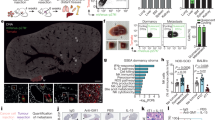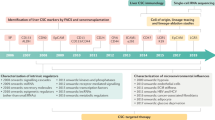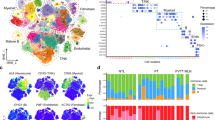Abstract
There is much debate about the way in which epithelial tumors metastasize. It has been proposed that the bone marrow (BM) acts as a tumor cell reservoir. We injected human hepatocellular carcinoma (HCC) cells (Mahlavu cell line) into the livers, circulation or BM of NOD/SCID mice and circulating tumor cells were quantified. When injected under the Glisson capsule, a primary tumor developed and continuously yielded circulating tumor cells. Liver tumor removal led to a very low level of Mahlavu cells both in blood and BM 30 days later. When Mahlavu cells (cultured or from BM of primary mice femurs) were intravenously injected into mice, the number of cells in the bloodstream (BS) steadily decreased, whereas the BM was not significantly colonized. When Mahlavu cells were directly injected into one femur, the controlateral femur was not colonized. Microscopic analysis and a sensitive PCR assay (<1 Mahlavu cell/nuclear cells) both failed to detect human tumor cells in other organs regardless of injection route. In conclusion, our model strongly supports the hypothesis that HCCs continuously release cells into the BS. However, in sharp contrast with the current hypothesis, the BM is not specifically colonized by tumor cells but could store them at a very low level.
This is a preview of subscription content, access via your institution
Access options
Subscribe to this journal
Receive 50 print issues and online access
$259.00 per year
only $5.18 per issue
Buy this article
- Purchase on Springer Link
- Instant access to full article PDF
Prices may be subject to local taxes which are calculated during checkout





Similar content being viewed by others
References
Association for the Study of the Liver (AISF) (1992). J Hepatol 14: 401–403.
Bernards R, Weinberg RA . (2002). Nature 418: 823.
Bismuth H, Chiche L, Adam R, Castaing D, Diamond T, Dennison A . (1993). Ann Surg 218: 145–151.
Braun S, Pantel K, Muller P, Janni W, Hepp F, Kentenich CR et al. (2000). N Engl J Med 342: 525–533.
Braun S, Schindlbeck C, Hepp F, Janni W, Kentenich C, Riethmuller G et al. (2001). J Clin Oncol 19: 368–375.
Chambers AF, Groom AC, MacDonald IC . (2002). Nat Rev Cancer 2: 563–572.
Chiappini F, Teicher E, Saffroy R, Pham P, Falissard B, Barrier A et al. (2004). Lab Invest 84: 908–914.
Cristofanilli M, Budd GT, Ellis MJ, Stopeck A, Matera J, Miller MC et al. (2004). N Engl J Med 351: 781–791.
Esumi T, Inaba M, Ichioka N, Kushida T, Iida H, Ikehara S . (2003). Transplantation 76: 1543–1548.
Fukutomi M, Yokota M, Chuman H, Harada H, Zaitsu Y, Funakoshi A et al. (2001). Eur J Gastroenterol Hepatol 13: 1083–1088.
Gerber B, Krause A, Muller H, Richter D, Reimer T, Makovitzky J et al. (2001). J Clin Oncol 19: 960–971.
Goodison S, Kawai K, Hihara J, Jiang P, Yang M, Urquidi V et al. (2003). Clin Cancer Res 9: 3808–3814.
Greene AK, Puder M . (2003). J Invest Surg 16: 99–102.
Gross-Goupil M, Saffroy R, Azoulay D, Precetti S, Emile JF, Delvart V et al. (2003). Ann Surg 238: 241–248.
Guller U, Zajac P, Schnider A, Bosch B, Vorburger S, Zuber M et al. (2002). Ann Surg 236: 768–775.
Harris RG, Herzog EL, Bruscia EM, Grove JE, Van Arnam JS, Krause DS . (2004). Science 305: 90–93.
Houghton J, Stoicov C, Nomura S, Rogers AB, Carlson J, Li H et al. (2004). Science 306: 1568–1571.
Ishikawa H, Nakao K, Matsumoto K, Nishimura D, Ichikawa T, Hamasaki K et al. (2004). Gut 53: 884–889.
Kienle P, Weitz J, Klaes R, Koch M, Benner A, Lehnert T et al. (2000). Arch Surg 135: 213–218.
Kushida T, Inaba M, Hisha H, Ichioka N, Esumi T, Ogawa R et al. (2001). Blood 97: 3292–3299.
Lemoine A, Le Bricon T, Salvucci M, Azoulay D, Pham P, Raccuia J et al. (1997). Ann Surg 226: 43–50.
Li QG, Yang GS, Yang Q, Wei LX, Yang N, Zhou XP et al. (2004). World J Gastroenterol 10: 903–905.
Lindemann F, Schlimok G, Dirschedl P, Witte J, Riethmuller G . (1992). Lancet 340: 685–689.
Liu Y, Wu MC, Qian GX, Zhang BH . (2003). Hepatobiliary Pancreat Dis Int 2: 414–417.
Louha M, Nicolet J, Zylberberg H, Sabile A, Vons C, Vona G et al. (1999). Hepatology 29: 879–882.
Majno PE, Adam R, Bismuth H, Castaing D, Ariche A, Krissat J et al. (1997). Ann Surg 226: 688–701.
Marx J . (2004). Science 306: 1455–1457.
Matsumura M, Niwa Y, Kato N, Komatsu Y, Shiina S, Kawabe T et al. (1994). Hepatology 20: 1418–1425.
Minata M, Nishida N, Komeda T, Azechi H, Katsuma H, Nishimura T et al. (2001). J Gastroenterol Hepatol 16: 445–451.
Osaki T, Oyama T, Gu CD, Yamashita T, So T, Takenoyama M et al. (2002). J Clin Oncol 20: 2930–2936.
Pantel K, Brakenhoff RH . (2004). Nat Rev Cancer 4: 448–456.
Pantel K, Cote RJ, Fodstad O . (1999). J Natl Cancer Inst 91: 1113–1124.
Pantel K, Izbicki J, Passlick B, Angstwurm M, Haussinger K, Thetter O et al. (1996). Lancet 347: 649–653.
Poon RT, Fan ST, Lo CM, Liu CL, Wong J . (2002). Ann Surg 235: 373–382.
Qin LX, Tang ZY . (2002). World J Gastroenterol 8: 193–199.
Ramaswamy S, Ross KN, Lander ES, Golub TR . (2003). Nat Genet 33: 49–54.
Sell S . (2002). Semin Cell Dev Biol 13: 419–424.
Soeth E, Vogel I, Roder C, Juhl H, Marxsen J, Kruger U et al. (1997). Cancer Res 57: 3106–3110.
Solakoglu O, Maierhofer C, Lahr G, Breit E, Scheunemann P, Heumos I et al. (2002). Proc Natl Acad Sci USA 99: 2246–2251.
Tsavellas G, Patel H, Allen-Mersh TG . (2001). Br J Surg 88: 1307–1320.
Van de Vijver MJ, He YD, van't Veer LJ, Dai H, Hart AA, Voskuil DW et al. (2002). N Engl J Med 347: 1999–2009.
Van't Veer LJ, Dai H, van de Vijver MJ, He YD, Hart AA, Mao M et al. (2002). Nature 415: 530–536.
Weigelt B, Glas AM, Wessels LF, Witteveen AT, Peterse JL, van't Veer LJ . (2003). Proc Natl Acad Sci USA 100: 15901–15905.
Woelfle U, Cloos J, Sauter G, Riethdorf L, Janicke F, van Diest P et al. (2003). Cancer Res 63: 5679–5684.
Acknowledgements
This work was supported by grants from Fondation de l'Avenir (ET4-358) and Association pour la Recherche contre le Cancer (ARC3436). Franck Chiappini has received a grant from the Association pour la Recherche sur le Cancer and Philippe Riou from the Ligue Contre le Cancer and the Société Française du Cancer.
Author information
Authors and Affiliations
Corresponding author
Rights and permissions
About this article
Cite this article
Scatton, O., Chiappini, F., Riou, P. et al. Fate and characterization of circulating tumor cells in a NOD/SCID mouse model of human hepatocellular carcinoma. Oncogene 25, 4067–4075 (2006). https://doi.org/10.1038/sj.onc.1209430
Received:
Revised:
Accepted:
Published:
Issue Date:
DOI: https://doi.org/10.1038/sj.onc.1209430
Keywords
This article is cited by
-
Bone metastases in hepatocellular carcinoma: an emerging issue
Cancer and Metastasis Reviews (2014)
-
Hepatocellular carcinoma: insight from animal models
Nature Reviews Gastroenterology & Hepatology (2012)
-
Circulating tumor cells: advances in detection methods, biological issues, and clinical relevance
Journal of Cancer Research and Clinical Oncology (2011)
-
Chick embryo chorioallantoic membrane model systems to study and visualize human tumor cell metastasis
Histochemistry and Cell Biology (2008)



